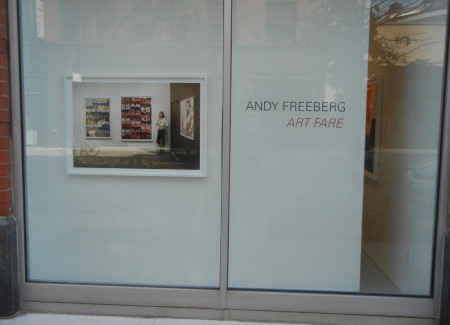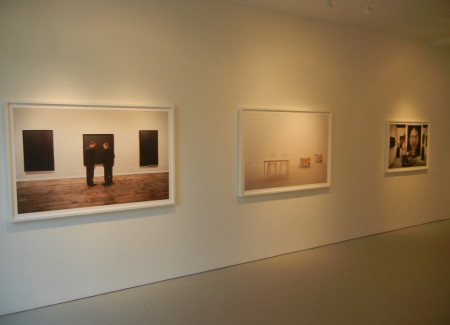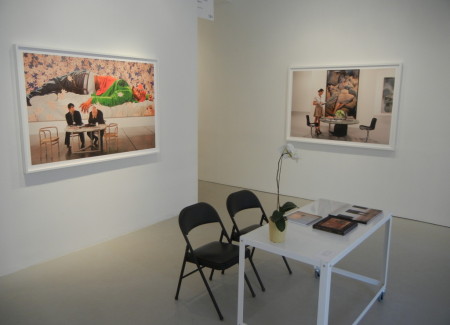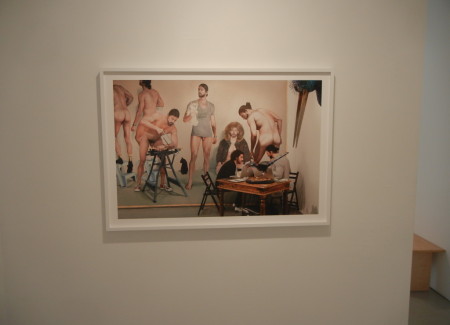JTF (just the facts): A total of 12 large scale color photographs, framed in white and unmatted, and hung against white walls in the divided gallery space and the front window. All of the works are archival pigment prints, made between 2009 and 2011. The prints are shown in two sizes: roughly 30×44 (in editions of 6+2AP) and roughly 40×60 (in editions of 3+2AP). There are 6 small prints and 6 large prints on display. A monograph of this body of work was recently published by Sojourn Books (here). (Installation shots below.)
Comments/Context: Like any subculture, the art world has its own peculiar behaviors and idiosyncrasies that pass for normal among members of the community but look entirely foreign to outsiders. With an anthropological eye for overlooked detail, Andy Freeberg has built his photographic career out of carefully observing the customs of the art world, from its purposefully unhelpful gallery front desks (Sentry) to the surprising juxtapositions of Russian museum guards and the treasures they dutifully protect (Guardian). In his newest series, he takes on the spectacle of the sprawling international art fairs, capturing the theater to be found among the warrens of white booths and designer-attired attendants, where the choice of the table and chairs or the cut of a suit sets the tone. Each booth offers a carefully controlled selling environment, and mixing the serendipity of street photography with the staged artifice of the photographic tableau, his pictures discover the unintended ironies and unlikely comedies that arise in such mannered places.
The simplest of Freeberg’s found oddities capture playful games of color matching. A red haired salesperson in a mustard colored shirt attends to her many electronic devices seemingly unaware of the red and yellow explosion swirling behind her (a Wolfgang Tillmans abstraction). A pair of black suited men have a hushed private conversation in front of a series of all black Ad Reinhardt paintings. A Cindy Sherman portrait in various tones of beige provides the perfect backdrop for a beige skirt in the Skarstedt booth. And a man in a pink shirt lounges in the Gagosian booth directly in front of an equally pink Mark Grotjahn painting. Each scene has a sense of unexpected visual harmony, a grace note snatched from the bustle of the proceedings.
Freeberg takes this matching idea one step further when the artworks on display share common traits with the people nearby. Prominent bald heads in works by Chuck Close and Hanneke Beaumont in the Contessa booth bear a striking resemblance to a bald head of gallery owner Steven Hartman. A wavy haired gallery attendant does some impromptu conservation work on the floor in the Charlotte Lund booth, while Denise Grunstein’s photographs of women’s faces obscured by their wavy hair hang on the wall behind. And Zachari Logan’s wall sized self portrait (made up of multiple images of himself) takes on yet another layer of doppelganger weirdness with the artist sitting right beneath it. In these works, Freeberg starts to cross over into visual comedy, the clever juxtapositions almost too good to be true.
The best of the works in this series find that moment when the booth becomes a diorama, its interactions and combinations tuned to perfection. Sean Kelly sits with his head in his hands, as though mourning the sprawled dead body in the monumental Kehinde Wiley painting behind him. Two gallery staff members stand disdainfully engrossed by their devices, oblivious to the eye popping Piotr Uklanski that is blasting off the wall beside them. And a woman stands nonchalantly talking on her phone, right next to one of Mel Bochner’s Blah Blah Blah paintings. The subtle skewering Freeberg delivers is nothing short of delightful.
Given the inherent ridiculousness of art fairs, there are of course other sets of pictures to be made that are far jokier, or that cut with more biting parody and caricature. But Freeberg’s photographs have a light touch, quietly mocking and teasing, but doing so with a level of reserve that isn’t threatening to his subjects. Pared down to small, elegantly crafted vignettes, his observations make us look again, exposing the ephemeral momentary humor that creates tiny cracks in the painstakingly serious façade.
Collector’s POV: The works in the show are priced as follows. The smaller 30×44 prints start at $6000 and the larger 40×60 prints begin at $7500. Prices then range upward based on the place in edition, reaching $30000 for the second AP in the largest size. Freeberg’s work has little secondary market history, so gallery retail remains the best/only option for those collectors interested in following up.











